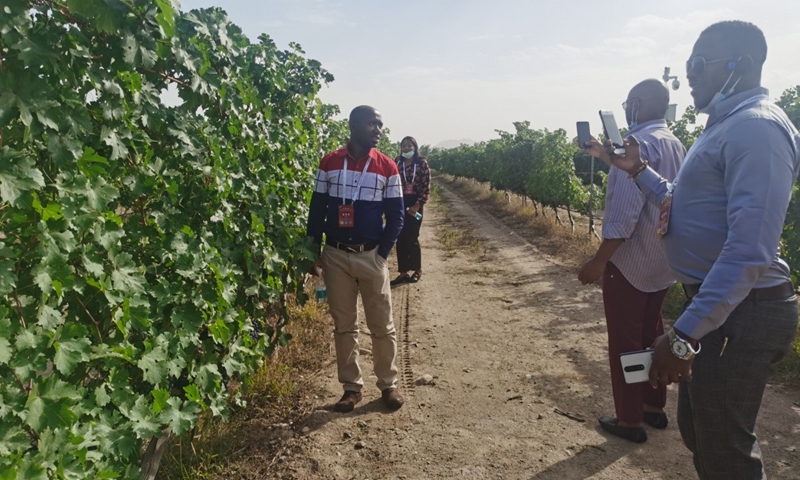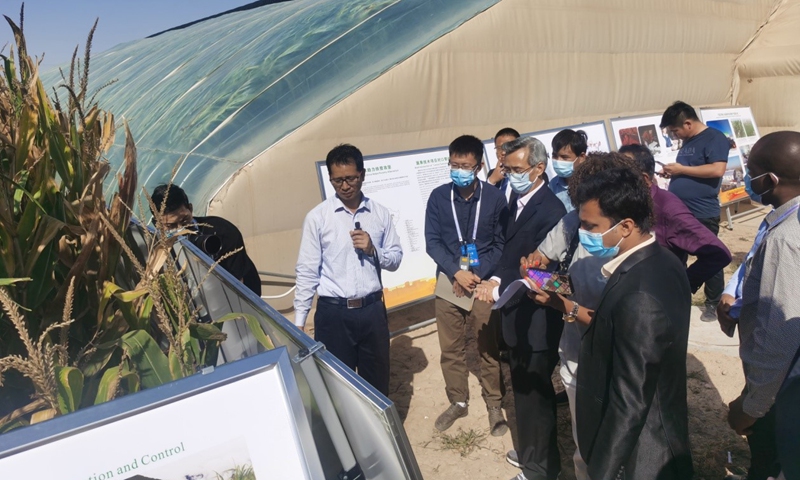Is China's poverty cure replicable? Minning town shares successful model with the world

Representatives from Africa visit a vineyard in Minning Town to learn its techniques to grow wine grapes on the Gobi Desert. Photo: Hu Yuwei/GT
Minning, a model town that reflectes China's most successful poverty alleviation efforts through a pair off support scheme between east and west China, is in the spotlight again after China's recent emphasis on common prosperity.
Under the scheme where affluent areas were tasked with helping less developed regions, the coastal province of Fujian was paired with Northwest China's Ningxia Hui Autonomous Region in a poverty alleviation initiative. Relocating villagers living in arid mountain areas to habitable regions near the Yellow River was a key project at that moment. The town has been the epitome of the philosophy of common prosperity for decades.
The per capita net income has risen nearly 30-fold in the past 26 years. The Gobi Desert wine industry is booming and specific industries, such as mushroom and wolfberry farming, are attracting young people to return to their hometowns to start businesses.
These successful experiences have also inspired developing countries and many wonder how the "golden seed" from the Gobi desert could be "transplanted" to their own land.
Resettled hope
The township became a popular attraction with many tourists flocking in after a Chinese TV drama series reflected the touching reality of poverty alleviation, gathering tens of millions of views across domestic platforms and overseas channels.
In 1997, villagers in Xihaigu, a region in Northwest China's Ningxia Hui Autonomous Region, had mostly barren land and suffered drought and fragile ecological conditions. They were relocated from the deep mountains to a habitable region near the Yellow River to rebuild their homes from scratch.
As the area was still an undeveloped wasteland, only 13 households agreed to migrate, even after two mobilization campaigns.
The journey of over 400 km from their hometown to new village can only be done on three-wheeled motorcycles, and the earliest migrants only had tents when they arrived, the governor of Minning town, Ma Xiaoming, said recalling the tough days of the first settlers.
Hard working and abundant irrigation gave the migrants a bumper harvest after that and the real achievements attracted more to move to the region.
The village, with a population of 8,000 residents 20 years ago, was turned into a demonstration town accommodating over 66,000 residents, whose annual disposable income soared from 500 yuan ($77.53) before the relocation to 14,961 yuan ($2,320) last year. Six incorporated villages gained over 6 million yuan each from rural collective economy in 2020, media reported.
The prosperity path cannot be achieved without support from the south. The first batch of migrant families had the assistance from East China's Fujian Province, a much wealthy coastal place during that year.
North-South cooperation to achieve common prosperity
China stressed efforts to promote common prosperity at the 10th meeting of the Central Committee for Financial and Economic Affairs.
In fact, the practice of common prosperity was fully implemented in Minning town in the 1990s.
In April 1997, an east-west collaboration and pairing assistance program was initiated. The impoverished residents in remote areas from Xihaigu to the Hetao Plain teamed up to build a new village named "Minning", with the Chinese character Min, an abbreviation of Fujian, and the character Ning, short for Ningxia.
With nearly 300 million yuan ($46.5 million) in donations, Fujian Province dispatched over 100 poverty-alleviation officials and entrepreneurs every year to assist Minning residents develop their own industries in the Gobi Desert in the 1990s under the collaboration program, Ma told the Global Times.
The pair off cooperation scheme for poverty alleviation shined in such difficult land and brought the "golden seed" to local residents.
Chen Deqi, an entrepreneur from Fujian who invested in the town and developed Helan Soul, his large-scale wine chateau on the desert, is a typical contributor and beneficiary of such pairing-off cooperation.
Chen first visited Ningxia in 2007 with a group of Fujian businessmen for investigation and he still remembers the pain of the sand and rocks blowing from the endless Gobi Desert scratching on his face. But Chen, who grew up in Fujian, a populated province with scarce land, realized that land was wealth but he needed to find the key to unlock it.
Chen finally decided to spend 200 million yuan ($31 million) to buy the 100,000-mu barren beach.
He began digging wells, installing power lines on the desert and bringing in frost-resistant vine saplings from France and Italy. He also imported drip irrigation systems from Israel and deployed them with high-quality water from Helan Mountain. Today, the Gobi desert he once had has been developed into 40,000 acres of vineyards.
The construction of vineyards not only improves the ecosystem but also promotes employment of migrants. Over the past 14 years, more than 3,000 local farmers, many of whom were living in poverty, have found jobs in Chen's vineyard guaranteeing them a monthly income of more than 3,000 yuan ($465). At present, the annual output value of the winery exceeds 1 billion yuan ($155 million) and contributes heavily to the local tax revenue, Chen told the Global Times.
Currently, the town's annual per capita disposable income has increased from 500 yuan ($77) when relocation began to 14,900 yuan ($2,310) last year, when more than 7,000 poverty-stricken households bid farewell to absolute poverty, according to Xinhua News Agency.
Today, the goal of common prosperity is still practiced between the two regions, as Ningxia exports labor to Fujian every year to support its factories and industries when manufacturing workers are in high demand, Ma told the Global Times.
Industries on Gobi Desert
In addition to wine, Juncao technology, which means fungus grass, is a technique developed by Chinese scientists to cultivate a hybrid grass that can be used on mushroom farming as well as an important multi-functional agricultural resource that has become another export business card of Minning Town. Today, Juncao has become an important tool for local environmental improvement and poverty alleviation thanks to the technology brought by professors from Fujian in the early years.

Representatives visit Minning Town to learn about the Juncao technology as well as its spread across the world as a Chinese contribution. Photo: Hu Yuwei/GT
As part of the pair off cooperation, agricultural experts Lin Zhanxi and Ling Yinong from Fujian led a team that traveled more than 2,000 km, from humid Fujian to an abandoned cave in Xihaigu's Pengyang county. Lin's new technology allows the fungi to grow on grass-based substrates instead of felled trees. This has brought hope to the sustainable development of developing countries.
Lin decided to plant Agaricus bisporus, a widely cultivated mushroom species with a short planting cycle and significant benefits, in a bid to resolve most pressing issues by training more local to plant the mushroom.
The successful trial attracted more locals to join and improved their confidence to settle down roots in the Gobi Desert and develop further diverse industries.
The Juncao technology has benefited 106 countries and regions by addressing poverty, soil erosion and desertification. The herb used in this technology is fondly called the "China Herb," "Happiness Herb," and "Sun Herb" by the locals. The Juncao technology has been promoted in 15 languages and over 10,000 people have been trained both at home and abroad, according to local officials.
At the UN High-Level Meeting on Juncao Technology in 2019, the President of the 73rd Session of the UN General Assembly, Ms María Fernanda Espinosa Garcés, said that "through Juncao technology, China has a great story to tell, a story now shared with over 100 countries who have benefited from this innovation."
Since 1999, when the Ministry of Commerce listed Juncao Technology as a foreign aid training program, 266 international training courses have been held in the Fujian Agriculture and Forestry University with 10,112 trainees and 21 students from 11 countries have been trained in Juncao. Overseas students have graduated and become the backbone of the development of this technology and a number of Juncao entrepreneurs have emerged, local officials mentioned.
The young representatives from Asia, Africa and Latin America visiting Minning Town were impressed by the poverty alleviation story in the Gobi Desert. They hope to learn from China's successful experience, including through science and technology Innovation, or the South-West cooperation, to repeat the miracle of poverty alleviation in their own countries. They also recognized China's concern for the greater good of humanity by introducing Juncao technology to more countries.

